APPUNTI DI UN VIAGGIO IN SICILIA. CORTOCIRCUITI TRA UN PASSATO MAI FINITO E UN FUTURO MAI ARRIVATO.
Testo di Davide Luca e Marilisa Iannuzzo
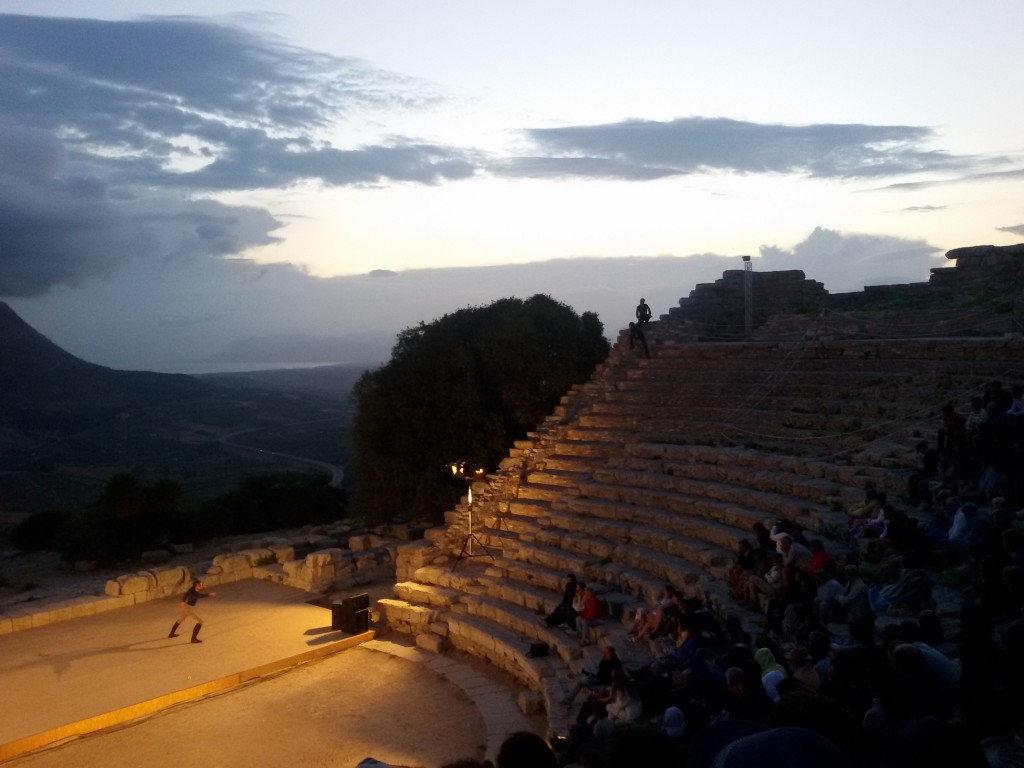
Il binomio tradizione-innovazione trova una declinazione particolare in una terra come la Sicilia, in cui il rapporto tra il tempo e l’opera umana assume una connotazione originale e paradigmatica, tale da rendere più complesso e articolato il rapporto tra i due termini iniziali della questione. In Sicilia il tempo è una dimensione nella quale il passato ha la forza di una presenza quasi permanente, con cui si è obbligati a confrontarsi continuamente, e la consistenza plastica di una materia che prende forma, vitalità e significato in base a come viene lavorata.
Arte e architettura si trovano davanti a due possibili atteggiamenti, radicalmente differenti. Da un lato, il rifiuto netto nei confronti di un passato e di una tradizione, vissuti come un’eredità troppo pesante e spesso negativa da cui tentare il riscatto; ecco quindi l’esigenza di un progetto utopistico di rigenerazione integrale dell’uomo, della società e del territorio su basi innovative. Dall’altro, la riscoperta che riattualizza il patrimonio sommerso e stratificato, che riscopre i fili che ci tengono legati alla tradizione, annullandone la distanza temporale rispetto al presente; attraverso il gesto commosso di comprensione delle tragedie del passato, cercando invano di cristallizzarne la memoria; o ancora il teatro come emozione collettiva del rito che si rinnova attraverso la magica simbiosi tra la potenza immanente del sito e le situazioni della commedia umana, costantemente reinterpretate sulla scena.
Questo scritto nasce al termine di un viaggio compiuto da noi in Sicilia, un itinerario che sulla strada ha preso la forma di un circuito deciso tappa per tappa. Nella mente invece è stato teso a cercare le trame e i nessi impliciti di significato tra luoghi e situazioni che si sono rivelati occasioni per stimoli continui e suggestioni comuni.
É stato un viaggio rivelatore delle diverse anime di un territorio complesso e sfaccettato, in continua tensione tra antico e moderno, tradizione e innovazione. Le esperienze raccolte si focalizzano su tre situazioni emblematiche., presentate attraverso un confronto abbinato. Siracusa, in cui emerge la duplice valenza dell’architettura come dispositivo di interpretazione visionaria di un sentimento religioso o come strumento rabdomantico per rintracciare identità nascoste nel passato. Noto, dove prevale l’immagine di una terra felice, con cui l’uomo ha stabilito un rapporto millenario produttivo e innovativo. La valle del Belice, dove arte e architettura hanno tentato (spesso invano) una terapia di risarcimento o rigererazione rispetto al trauma causato dal terremoto. Alla fine forse l’unica possibilità di riannodare i fili tra passato e presente sta nella pratica dei luoghi da parte della gente, nella continua contaminazione e rivisitazione dei testi antichi, con occhi nuovi e mente nuova.
Luoghi del sacro a Siracusa, tra riscoperta contemporanea dell’antico e visione moderna del sentimento religioso
Artemision / Ortigia, Siracusa. L’architettura come finestra sul passato.
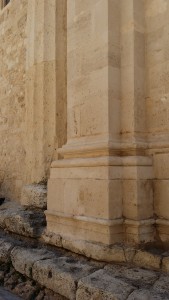
Sull’isola di Ortigia, antico cuore storico della città di Siracusa, lungo piazza Minerva sfila una teoria di colonne doriche incastonate nel paramento murario dell’attuale Duomo, ex tempio di Atena. Ad un certo punto si apre un varco nella cortina degli edifici. Si viene come risucchiati all’interno, in uno spazio inatteso e sorprendente, in cui i riflessi lucenti della massiccia pietra gialla si stemperano in una delicata tessitura di doghe di legno. Un luogo raccolto in una soffusa penombra, da cui iniziare un viaggio da fermi nel ventre della città, nei suoi strati coperti. Siamo infatti nel naos, il cuore del tempio di Artemide di cui non rimane traccia che delle fondamenta, sovrapposte a loro volta ai resti di un abitato pre greco.
Il padiglione dell’Artemision funge da copertura agli scavi ed è contemporaneamente luogo di riscoperta della memoria storica della città, senza peró mai perdere di vista il sottile legame con il presente e con ció che del passato è una testimonianza visibile e incorporata nella struttura fisica di Siracusa. Infatti questa poetica incisione, un taglio stretto e lungo sulla facciata esterna, è in realtà una finestra da cui inquadrare perfettamente la colonna d’angolo del Duomo antistante l’Artemision, rivelando l’allineamento tra i due templi antichi. Un caso questo in cui l’innovazione e la bellezza del gesto architettonico contenporaneo consiste nell’autonegazione, nel valore del vuoto che seleziona e mette in una nuova luce il passato.
Santuario della Madonna delle Lacrime / Siracusa. Schegge atopiche di futuro nella città generica.
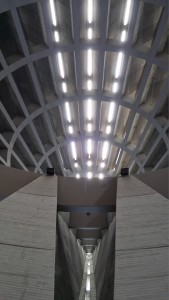
Immersa nella periferia di Siracusa svetta una guglia che si appoggia a terra sfaccettandosi in una raggiera di fasci e petali di cemento a vista. La chiesa presenta una pianta centrale e una forma conica, composta da costoloni incisi da tagli di luce lungo lo sviluppo verticale della struttura. Nonostante l’imponenza dell’edificio, il rapporto con il suolo è morbido e leggero. L’anello di base sembra infatti sospeso da terra, scomposto in una serie di corpi aggettanti che ospitano le cappelle della grande aula centrale alla quale si viene introdotti percorrendo delle rampe radiali che accompagnano il movimento ascensionale di tutta la struttura. L’impressione è quella di essere accolti all’interno delle pieghe di una veste sacra di meravigliose dimensioni. Progettata negli anni ’60 da due architetti francesi, la chiesa é un esempio di come il brutalismo delle strutture metaboliste in cemento armato avesse nelle proprie corde la capacità di commuovere ed elevare lo spirito. Tuttavia la moderna concezione architettonica proponeva un’interpretazione troppo futurista per un sentimento religioso e popolare forse troppo antico per accettare il “vestito” della modernità. La costruzione infatti, iniziata nel 1966 e andata avanti tra contestazioni e polemiche, si è conclusa solo nel 1994.
Radicamenti evolutivi nel territorio di Noto. Esempi di un rapporto millenario e vitale con la terra
Un bioagriturismo / Noto. Strutture antiche per nuovi modelli di turismo e di vita.
Poco lontano da Noto, tra colline punteggiate da uliveti, carrubi e mandorli, e impreziosite da un ricamo di muretti a secco in pietra bianca, c’è l’agriturismo di Alfonso e Lucia, rispettivamente una guida turistica e un’archeologa che hanno recuperato il vecchio casolare di famiglia riadattandolo ad agriturismo. Un’esperienza ormai diffusa questa, che favorisce il turismo lento e a contatto con il territorio e i prodotti locali. Ma la novità sta nella scelta di diversificare e ampliare l’attività verso le scuole e i bambini integrando l’agritursmo con un agri-asilo, in cui poter insegnare a riconoscere le specie, familiarizzando con l’ambiente rurale di una fattoria. Un esempio virtuoso di una micro realtà economica su base familiare come avveniva in passato, ma diversificata e aperta alle nuove esigenze della società attuale.
Villa romana / Tellaro. Un’archeomasseria.
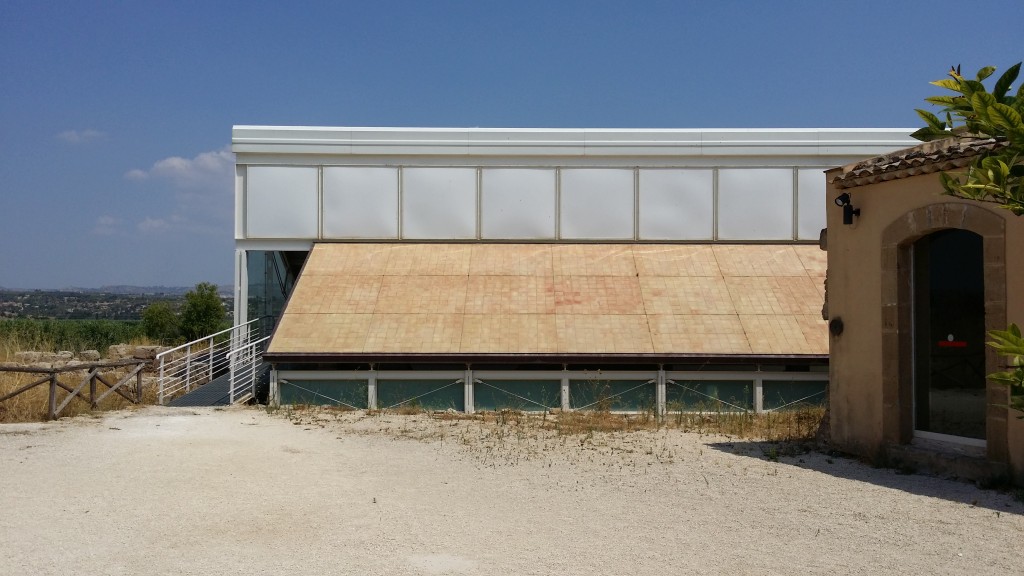
Nel territorio di Noto, in mezzo alla campagna coltivata, segnalata timidamente da qualche cartello stradale, si trova una masseria che nasconde al proprio interno un tesoro inaspettato. Arrivando alla masseria ci si trova davanti ad una struttura tradizionale in pietra, ma una volta dentro ci si accorge che l’edificio rustico poggia i piedi su un prezioso tappeto di mosaici, con motivi floreali, scene mitologiche ed episodi di caccia ancora perfettamente conservati in tutta la loro forza espressiva. 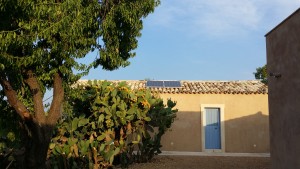 Era la villa romana del Tellaro, una delle più estese e ricche tenute agricole del periodo romano e testimonianza di un momento in cui la Sicilia era al centro di una cultura artistica e figurativa che parlava un linguaggio mediterraneo. Gli scavi sono coperti da una struttura metallica a doppia falda, agganciata all’antico fabbricato e tamponata in cotto verso il casale e in vetro verso il paesaggio della campagna. I mosaici e i loro ricchi motivi geometrici continuano ad essere fonte di ispirazione e materiale didattico e di studio per le scuole, come si vede dai lavori ospitati negli spazi del casale.
Era la villa romana del Tellaro, una delle più estese e ricche tenute agricole del periodo romano e testimonianza di un momento in cui la Sicilia era al centro di una cultura artistica e figurativa che parlava un linguaggio mediterraneo. Gli scavi sono coperti da una struttura metallica a doppia falda, agganciata all’antico fabbricato e tamponata in cotto verso il casale e in vetro verso il paesaggio della campagna. I mosaici e i loro ricchi motivi geometrici continuano ad essere fonte di ispirazione e materiale didattico e di studio per le scuole, come si vede dai lavori ospitati negli spazi del casale.
A TRIP TO SICILY NOTES. SHORT CIRCUITS BETWEEN A NEVER ENDING PAST AND NEVER ARRIVING FUTURE.
Text by Davide Luca and Marilisa Iannuzzo, translations by Laura Dumbrava
The combination of the terms “tradition-innovation” has a particular meaning in a land as Sicily in which the relationship between time and human action assumes an original and paradigmatic character.Such relation makes the binomial stated before more complex.In Sicily, time is a dimension which makes past strong as an almost permanent presence; we are obliged to continuously confront with it, which assumes a plastic consistence such to have shape, vitality and meaning according the way in which it is worked.
Art and architecture are found in front of two possible attitudes, radically different.On the one hand, the complete refusal towards a certain past and tradition which are lived as a very heavy heritage and often negative from which freedom is an attempt.Here it is, therefor, the exigency of an Utopian project of an integral regeneration of the human being, of the society and of the territory according to the innovative groundwork.On the other hand, the rediscovery makes again the heritage actual, black and stratified and it rediscovers the strings which keep us linked to tradition by cancelling the temporal distance compared to present; through the affected act of understanding the tragedies of the past by seeking in vain to eternally recall them; still, the theatre can be thought as a collective emotion and as a rite which renovates itself through the magical collaboration between the power of a place and the situations of the human comedy.
This writing was created at the end of a trip made by us in Sicily, an itinerary which on the road got the shape of a route which we have decided step by step.In our minds, instead, we tried to understand the plots and links of meaning between places and situations; occasions had been revealed for continuous stimuli and common suggestions.
It was a trip which revealed that the territory has different souls and it is complex and faceted, in a continuous tension between ancient and modern, tradition and innovation. The collected experiences are concentrated upon three situations which are presented across a combined confront.Syracuse, in which the double architecture value emerges as an instrument of visionary interpretation as a religious feeling or as a “dowsing” instrument designed to search out for hidden identities within the past.Noto, where the image of a happy land prevails and with which man stabilized a millenary, productive and innovative relationship.Belice Valley, where art and architecture tried (often in vain) a compensation therapy or a regeneration compared to the trauma caused by the earthquake.Finally, maybe the only possibility to knot again the links between past and present is to be found in the practice of places by the people in a continuous contamination and revisiting of ancient texts through a new perspective.
Syracuse’s holy places, between contemporary rediscover of the Ancient and modern vision of the religious feeling.
Artemision / Ortigia, Syracuse.Architecture as a window over the past.
On the Ortigia island, the ancient heart of the town of Syracuse, along the Minerva market, there are a series of “doriche” columns embedded within the walls of the actual cathedral, ex temple of Athena.
At a certain point, a passage among the buildings opens.It is like being sucked indoors, in a surprising and unexpected space in which the bright reflexions of the yellow massive rock dilute themselves in a delicate web of wood slats.A place, which is collected in a widespread penumbra from which a trip in the womb of the town, in its covered layers, begins.We are, in fact, in the “naos”, the heart of Artemis temple from which it remained the foundations only by overlapping at their turn over the pieces of a previous place.Artemis’ pavilion covers the excavations and it is a place of rediscovering the historical memory of the town – without, however, forgetting the slight connection with the present and with everything from the past which it is a visible and incorporated witness in Syracuse’s physical structure.Indeed, a poetic, tight and long cut on the external part is, in reality, a window from which the cathedral’s column corner, in front of the Artemis, can be perfectly framed and it reveals the alignment between the two ancient temples.This is a case in which the innovation and beauty of the contemporary architectonic act consists in auto-negation, in the value of the empty which selects and puts in a new light the past.
Madonna delle Lacrime sanctuary / Syracuse.Typical chippings of future in the generic town.
Emerged in the Syracuse’s periphery, a spire soars which lean itself on the ground with elements of cement which resemble petals.The church has a central plan and a conical shape made up of “ribs” which are engraved by clips of light along the vertical development of the structure.Despite the prominence of the building, its relationship with the soil is soft and light.The basic ring seems in fact suspended from the ground and decomposed in a series of suspended shapes which contain the chapels of the great central hall.The chapels can be accessed by walking radial ramps which accompany the movement towards the structure’s high. The impression is that of being received inside by folds of holy clothes.The church was designed in the 60’s by two French architects and it is an example of “brutalism” of “metabolised” structures in armed cement.This, however, has the ability to affect and elevate the spirit.Nevertheless, the modern architectonic conception suggested an interpretation too futuristic for a religious and popular feeling, maybe, too much ancient to accept the “dress” of modernity.The construction, in fact, began in 1966 and it went on among protests and arguments and it concluded only in 1994.
Evolutive rootedness in Noto’s territory.Examples of millenary and vital relationship with earth.
A bioagritourism / Noto.Ancient structures for the new models of tourism and life.
Not very far from Noto, among valleys pointed by olive trees, carob trees and almond trees and embellished by an embroidery of low white rock walls, it is Alfonso’s and Lucia’s agritourism.They are actually a tourist guide and an archaeologist and they had recovered the old family’s cottage in order to do agritourism.It is an experience widespread, by now; it encourages the slow and the contact with territory and local products tourism.But the news is the choice to diversify and enlarge the activity towards schools and children by integrating the agritourism with an “agri-kindergarden”, in which it can be taught how to recognize the species by having experience with a factory’s environment.A virtuous example of a micro economic reality with familiar basis as it was in the past, but different and opened to the new exigences of the actual society.
Roman villa / Tellaro.An archaeological farm.
In Noto’s territory, in the middle of the cultivated country, there is a “farm” – shyly reported by some road signs – which hides in its inside an unexpected treasure.Arriving at the farm, we are found in front of a traditional rock structure but once, it can be noticed that inside the building leans its basis on a precious mosaic carpet, with floral motifs, mythological scenes and hunting episodes still perfectly conserved in all their expressive force.It was the Roman villa of Tellaro, one of the most extended and rich agricultural estate of the Roman period and testimony of a moment in which Sicily was at the center of an artistic and figurative culture which talked a Mediterranean language.The excavations are covered by a metallic structure made up of double flap, docked to the ancient made, made up of tiles towards the house and made up of glass towards the country’s landscape.The mosaics and their rich geometrical motifs continue to be source of inspiration and didactic
and study material for schools as it can be seen in the works hold in house’s spaces.
